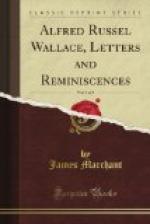It was probably about two years later (1846) that he first confided his completed work—up to that date—to Sir Joseph Hooker, and later to Sir Charles Lyell; refraining, however, except in general conversation with other scientists, from informing anyone of the progress he was making towards a positive solution of the problem. His attitude of mind and manner at this period is happily illustrated by Huxley, who, speaking of his early acquaintance with Darwin, says: “I remember in the course of my first interview with Darwin expressing my belief in the sharpness of the line of demarcation between natural groups and in the absence of transitional forms, with all the confidence of youth and imperfect knowledge. I was not aware, at that time, that he had then been many years brooding over the Species question; and the humorous smile which accompanied his gentle answer, that such was not altogether his view, long haunted and puzzled me.”
Little did Charles Darwin dream that, only three years after this first MS. was written (in 1844), a youthful naturalist—known only as a surveyor at Neath—was deliberately pondering over the same issue, and writing to his only scientific friend on the subject. As, however, the different methods of thought by which they arrived at the same conclusion is so aptly related by Wallace himself, we will leave it for him to tell the story in its appointed place.[21]
In 1856, the year following the appearance of Wallace’s essay in the Annals and Magazine of Natural History, both Hooker and Lyell urged Darwin to publish the result of his long and patient research. But he was still reluctant to do so, not having as yet satisfied himself with regard to certain conclusions which, he felt, must be stoutly maintained in face of the enormous amount of criticism which would arise immediately his theory was launched on the scientific world. And thus the event was postponed until the memorable year 1858.
Up to the year 1856 no correspondence had passed between Wallace and Darwin, so far, at least, as the former could remember, for he says, in a letter dated Frith Hill, Godalming, December 3, 1887 (written to Mr. A. Newton): “I had hardly heard of Darwin before going to the East, except as connected with the voyage of the Beagle.... I saw him once for a few minutes in the British Museum before I sailed. Through Stevens, my agent, I heard that he wanted curious varieties which he was studying. I think I wrote about some varieties of ducks I had sent, and he must have written once to me.... But at that time I had not the remotest notion that he had already arrived at a definite theory—still less that it was the same as occurred to me, suddenly, in Ternate in 1858.” It is clear, therefore, that the essay written at Sarawak formed the first real link with Darwin, although not fully recognised at the time. In May, 1857, Darwin wrote to Wallace: “I am much obliged for your letter ... and even




